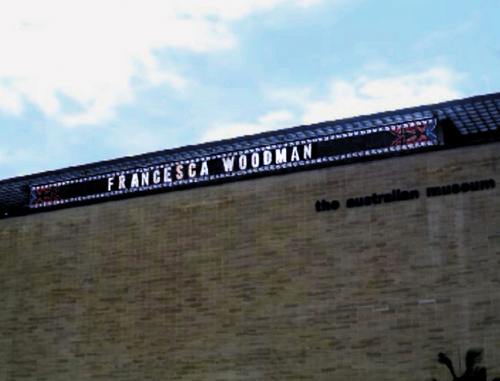
Susan Silton. “Kay,” from Who’s in a Name?, 2013. Offset lithographed screen grab.
In January 2011, John Baldessari launched a public art project called Your Name in Lights. Consisting of a glittery, Broadway-style LED display installed on the front of a participating museum, the project enabled up to 100,000 participants to register their name to be lit up on the marquee for 15 seconds. The marquee, which ran continuously for a period of about three weeks at each venue, was livestreamed over the internet. Participants were notified of the day and time when their names would appear, so they could watch for it and even document it.
In announcements for the project, Baldessari jauntily claimed it as a continuation of Andy Warhol’s dictate that in the future, everyone would be famous for 15 minutes; in the Internet age, that shelf life has been reduced to 15 seconds. The project was lauded as a huge success. It met with much fanfare when it premiered as part of the 2011 Sydney Festival, appearing on the front of the Australian Museum. Later that year, the Stedelijk Museum in Amsterdam, which was then still under re-construction, giddily seized their display of Your Name in Lights as an opportunity to announce itself a forthcoming and notable arts destination.
Those who would be more critical of the work might venture to say that Your Name in Lights is an easy, derivative crowd-pleaser that states the obvious while doing nothing to advance or complicate an idea that was way ahead of its time when first uttered. Indeed, the fact that its popular reception rests so squarely on how much pleasure and excitement it gives to people might make it more complicit with celebrity culture than critical of it. Regardless, both the project’s conception and its execution are lacking in nuance, sounding only one note as it lands, and not a very compelling note at that.

Susan Silton. “Jack,” from Who’s in a Name?, 2013. Offset lithographed screen grab. Silton chose to also make this image into a large painting, which resonated with the large, glittery spectacle paintings of the late Jack Goldstein.
Such a flaccid effort practically begs for an intervention, and that is exactly what artist Susan Silton undertook. In advance of the project’s launch in Sydney, Silton put out a call for Los Angeles artists who would be willing to register the name of another artist to be lit up on Baldessari’s display. The twist was that the names to be registered all belonged to artists who had committed suicide. Fifty-nine artists, including Silton herself, agreed to participate. A few requested to register the names of friends who had committed suicide, but most were randomly assigned a name that Silton sourced from an online wiki archive.
Once the registration was complete, the artists informed Silton of the time that their name would appear on the marquee. Using her computer, Silton was able to capture screen images of each of the names as they appeared on the livestream. She decided to put all of these images into a book, which would be titled, like the intervention itself, Who’s in a Name? At the same time, Silton assembled a dozen art historians and writers to research and compose short, 200-word biographies of all the artists who had participated in this project, both living and dead. These images and texts, along with bios of the writers and a commissioned essay from noted scholar Liz Kotz, form the substance of Silton’s book, which will be released next month in a clothbound edition of 500.

Susan Silton. “Francesca,” from Who’s in a Name?, 2013. Offset lithographed screen grab.
Silton’s project has precisely what Baldessari’s lacks, which is weight, complexity, and the capacity to be read on multiple levels. Who’s in a Name? evokes a cluster of issues associated with the impact that texts have on the reception of artists and their work. We are led to consider, for example, the power dynamics inherent to naming—whose names get chosen and for what purpose, in what context, and by whom. We are also presented with the 200-word bio—a standard device for summarizing an artist’s life and work, and one rife with inadequacy and absurdity. That absurdity becomes especially stark in the face of the muteness of the artists themselves in this project, none of whom, whether living or dead, are given space in the publication to speak for themselves. We think about other methods that are used to document and canonize artists, and how effective or accurate or lacking they may be.
And then there is the element of suicide. If Baldessari’s project was light-hearted and at least superficially optimistic, Silton’s intervention provided a dark and heavy counterpoint, a Jungian shadow as it were. Suicide, the ultimate act of self-erasure, is the logical flipside to fame, always lurking somewhere just beneath the public consciousness, inspiring fear or pity or perhaps a furtive empathy. Suicide is the circumstance that is usually not named out loud, but rather conveyed in hidden codes, so pervasive is the assumption of shame that goes with it. Suicide is as much shrouded in human darkness as fame is bathed in artificial lighting.
Finally however, there is comfort to be taken in the fact that Who’s in a Name? transcends the trap of individuality and isolation that both celebrity and suicide can be corollaries to. It’s lonely at both the top and the bottom, but by involving a community of democratically engaged artists and writers in this project, Silton diffuses the concentrated energy of the fame/erasure monster and splinters it into a wash of effects, to be looked at and talked about.
Susan Silton’s Who’s in a Name? will have a publication launch event on Saturday, May 18, 2–5pm, at MOCA Grand Avenue in Los Angeles. Thirty of the participating artists will present short readings and performances in response to the project.



